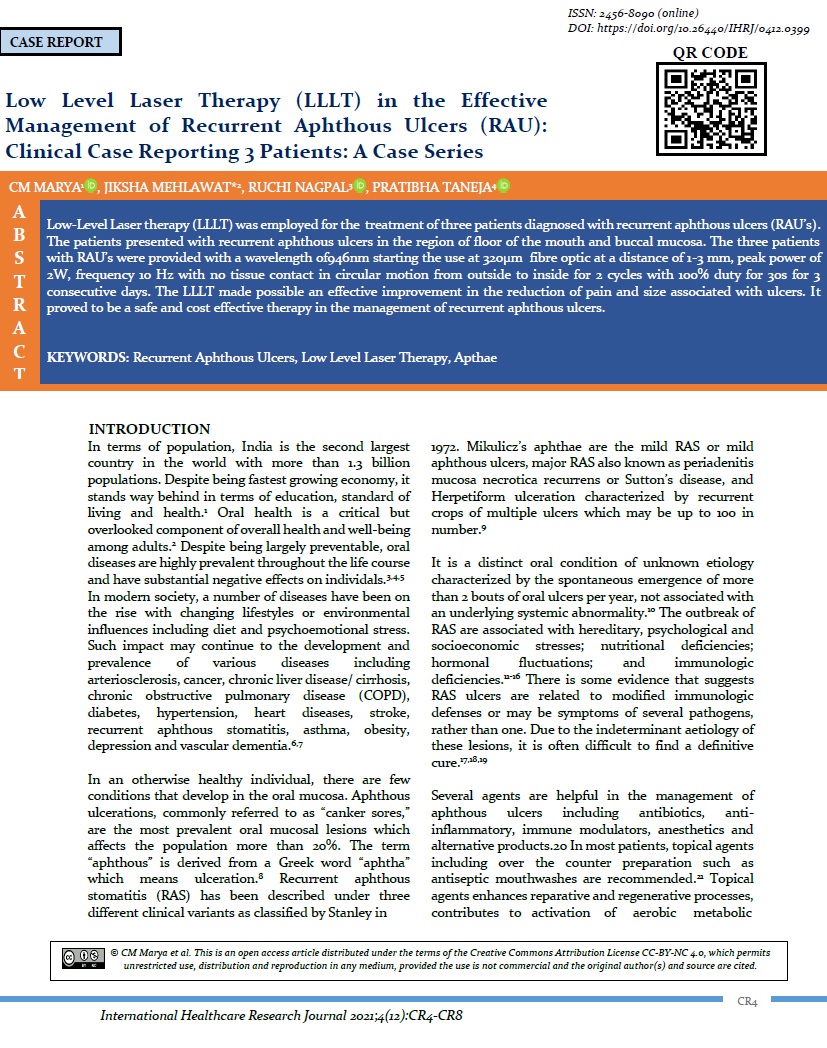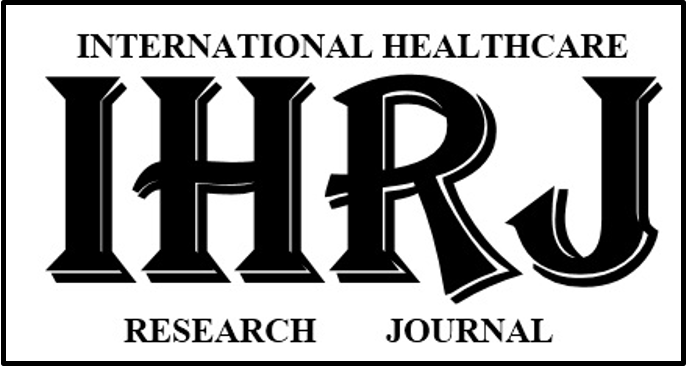Low Level Laser Therapy (LLLT) in the Effective Management of Recurrent Aphthous Ulcers (RAU): Clinical Case Reporting 3 Patients: A Case Series
Abstract
Low-Level Laser therapy (LLLT) was employed for the treatment of three patients diagnosed with recurrent aphthous ulcers (RAU’s). The patients presented with recurrent aphthous ulcers in the region of floor of the mouth and buccal mucosa. The three patients with RAU’s were provided with a wavelength of946nm starting the use at 320µm fibre optic at a distance of 1-3 mm, peak power of 2W, frequency 10 Hz with no tissue contact in circular motion from outside to inside for 2 cycles with 100% duty for 30s for 3 consecutive days. The LLLT made possible an effective improvement in the reduction of pain and size associated with ulcers. It proved to be a safe and cost effective therapy in the management of recurrent aphthous ulcers.
Downloads
References
Census (2011), Primary Census Abstracts, Registrar General of India, Ministry of Home affairs, Government of India. (Online Article) Available from http://www.census2011.co.in/facts/topdistrictpopulation.html. [Last accessed on 10th July, 2020].
Raju SH, Fareed N, Sudhir KM, Krishna Kumar R. Caries risk assessment among subjects with periodontal disease using cariogram study model. J Indian Assoc Public Health Dent. 2016;14:266-71. https://doi.org/10.4103/2319-5932.189838
Kassebaum NJ, Smith AGC, Bernabé E, et al. Global, regional, and national prevalence, incidence, and disability-adjusted life years for oral conditions for 195 countries, 1990–2015: a systematic analysis for the global burden of diseases, injuries, and risk factors. J Dent Res. 2017; 96: 380–7. https://doi.org/10.1177/0022034517693566
Petersen PE, Bourgeois D, Ogawa H, Estupinan-Day S, Ndiaye C. The global burden of oral diseases and risks to oral health. Bull World Health Organ. 2005; 83: 661–9.
Peres MA, Macpherson LMD, Weyant RJ, Daly B, Venturelli R, Mathur MR, Listl S, Celeste RK, Herreño CCG, Kearns C, Benzian H, Allison P, Watt RG. Oral diseases: a global public health challenge. The Lancet 2019; 394: 249–60. https://doi.org/10.1016/S0140-6736(19)31146-8
Al-Omiri MK, Karasneh J, Lynch E. Psychological profiles in patients with recurrent aphthous ulcers. Int J Oral Maxillofac Surg.2012;41(3):384–8. https://doi.org/10.1016/j.ijom.2011.12.024
Gurleyen EK, Erişen MO, Cakir O, Uysal O, Gulsum AK. Quality of life in patients with recurrent aphthous stomatitis treated with a mucoadhesive patch containing citrus essential oils. Patient Preference and Adherence 2016:10 967–73. https://doi.org/10.2147/PPA.S106530
Anand V, Gulati M, Govila V, Anand B. Low level laser therapy in the treatment of aphthous ulcer. Indian Journal of Dental Research.2013;24:267-70.
Stanley HR. Aphthous lesions. Oral Surg Oral Med Oral Pathol 1972;30:407‑16.
Tappuni AR, Kovacevic T, Shirlaw PJ, Challacomb SJ. Clinical assessment of disease severity in recurrent aphthous stomatitis. J Oral Pathol Med. 2013;42:635–41.
Pederson A, Klausen B, Hougen HP, Stenvang JP. T- lymphocyte subsets in recurrent aphthous ulceration. J Oral Pathol Med 1989;18:59. 10.1111/jop.12059
Nsamba C, Kaluskar SK. Inheritance of recurrent aphthous ulceration of the mouth. J Laryngol Otol 1986;100:361.
Ship II, Morris AL, Durocher RT, Burket LW. Recurrent aphthous ulcerations in a professional school student population. IV. Twelve month study of natural disease patterns. Oral Surg Oral Med Oral Pathol. 1961;4:30.
Crivelli MR, Adler SAI, Quarracino C, Bazerque P. Influence of socioeconomic status on oral mucosa lesion prevalence in school children. Community Dent Oral Epidemiol. 1988;16:58.
Wray D, Ferguson MM, Mason DK, Hutcheon AW, Dagg JH. Recurrent aphthea: Treatment with vitamin B^. folic acid and iron. Br Med J. 1975; 212:490.
Ferguson MM, Carter J, Boyle P. An epidemiological study of factors associated with recurrent aphthae in women. J Oral Med. 1984;39:212.
Scully C, Porter S. Recurrent aphthous stomatitis: current concepts of etiology, pathogenesis and management. J Oral Pathol Med. 1989; 18(1):21-7.
Vivek V, Nair BJ. Recurrent Aphthous Stomatitis: Current Concepts in Diagnosis and Management. JIAOMR 2011;23(3):232-6. https://doi.org/ 10.5005/jp-journals-10011-1135.
American Academy of Periodontology. Proceedings of the World Workshop in Clinical Periodontics. Chicago: American Academy of Periodontology 1989; X-9.
Mcbride DR. Management of Aphthous Ulcers. Am Fam Physician.2000;62(1):149-54.
Hamdy AAEM, Ibrahem MAE. Management of Aphthous Ulceration with Topical Quercetin: A Randomized Clinical Trial. J Contemp Dent Pract. [Internet]. 2010; 11(4):9-16.
Woo SB, Sonis ST. Recurrent aphthous ulcers: a review of diagnosis and treatment. J Am Dent Assoc. 1996; 127(8):1202-13.
Bagán JV, Sanchis JM, Milián MA, Peñarrocha M, Silvestre FJ. Recurrent aphthous stomatitis. A study of the clinical characteristics of lesions in 93 cases. J Oral Pathol Med. 1991; 20(8):395-7.
Ueta E, Osaki T, Yoneda K, Yamamoto T, Kato I. A clinical trial of Azelastine in recurrent aphthous ulceration, with an analysis of its actions on leukocytes. J Oral Pathol Med. 1994; 23(3):123-9.
Calvo TR, Lima ZP, Silva JS, Ballesteros KV, Pellizzon CH, Hiruma-Lima CA, Tamashiro J, Brito AR, Takahira RK, Vilegas W. Constituents and antiulcer effect of Alchornea glandulosa: activation of cell proliferation in gastric mucosa during the healing process. Biol Pharm Bull. 2007; 30(3):451-9.
Bladowski M, Choroszucha HK, Choroszucha T. Comparison of treatment results of recurrent aphthous Stomatitis (RAS) with low and high power laser irradiation vs a pharmaceutical method (5 year study). J Oral Laser Applications. 2004;4:191-209.
David R. Mcbride. Management of aphthous ulcers. Am Fam Physician. 2000;62(1):149-54.
De Souza TO, Martins MA, Bussadori SK, Fernandes KP, Tanji EY, Mesquita Ferrari RA, et al. Clinical evaluation of low level laser Low level laser treatment for recurring aphthous stomatitis. Photomed Laser Surg 2010;28:S85-8.
Khademi H, Shirani AM, Nikegbal F. Evaluation of low level laser therapy in recurrent aphthous stomatitis. J Dent Shiraz Univ Med Sci. 2009;10:160 2.
Aggarwal H, Singh MP, Nahar P, Mathur H, Sowmya GV. Efficacy of Low Level Laser Therapy in Treatment of Recurrent Aphthous Ulcers. Journal of Clinical and Diagnostic Research 2014,8(2):218-20. https://doi.org/10.7860/JCDR/2014/7639.4064

Copyright (c) 2021 CM Marya et al.

This work is licensed under a Creative Commons Attribution-NonCommercial 4.0 International License.


